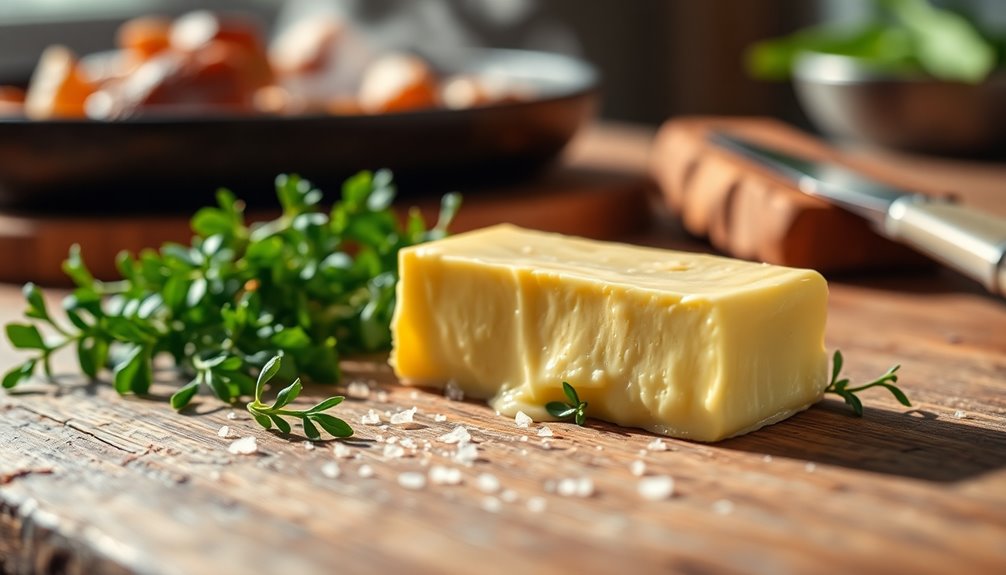I’ve always been curious about the calorie count in a tablespoon of butter. It’s an ingredient frequently used in numerous dishes, yet knowing its calorie amount is crucial for individuals aiming to control their weight.
In this article, we’ll dive into the composition of butter and explore its calorie count. We’ll also discuss how butter can fit into a healthy diet and the importance of moderation.
So, if you’re curious about the caloric impact of that dollop of butter, keep reading!
Key Takeaways
- Butter is composed of milk fat, water, and milk solids, with approximately 80% of its content being milk fat.
- A tablespoon of butter contains approximately 102 calories, which is more than a medium-sized apple and almost double the calories of a large carrot.
- Portion control is crucial when consuming butter, as it is high in saturated fat and can increase the risk of heart disease.
- Healthier alternatives to butter include olive oil, avocado, or nut butters, and practicing portion control can help manage weight and reduce calorie intake.
The Composition of Butter
Butter is made up of milk fat, water, and milk solids. It undergoes a composition analysis to determine its nutritional breakdown. This analysis shows that butter is primarily composed of fat, with about 80% of its content being milk fat. The remaining 20% is a combination of water and milk solids.
The fat content in butter gives it its rich and creamy texture, making it a popular ingredient in cooking and baking. However, it’s important to note that butter is also high in saturated fat, which can increase the risk of heart disease when consumed in excess.
Therefore, it is recommended to consume butter in moderation as part of a balanced diet.
Understanding Caloric Content
When it comes to understanding the caloric content of butter, two key points to consider are its calorie density and the impact of portion size.
Butter is a highly calorie-dense food, meaning that it contains a significant number of calories per gram. This is important to keep in mind when measuring out portions, as even a small increase in serving size can lead to a notable increase in calorie intake.
Butter Calorie Density
The calorie density of a tablespoon of butter is relatively high, containing approximately 102 calories. To put this into perspective, here is a comparison of the calorie content of a tablespoon of butter with other common foods:
- A tablespoon of butter has more calories than a medium-sized apple.
- It contains almost double the calories of a large carrot.
- It has more than three times the calories of a cup of spinach.
When it comes to measuring and converting butter calories, it is important to be mindful of portion sizes. Butter is a concentrated source of calories and should be consumed in moderation. To accurately track your calorie intake, it is helpful to use a food scale or consult a reliable calorie database.
Keep in mind that different brands and types of butter may have slight variations in calorie content, so it’s always a good idea to check the nutrition label for accurate information.
Impact of Portion Size
To accurately track your calorie intake, it’s helpful to be mindful of portion sizes when measuring and converting butter calories. The impact of portion size on our overall calorie intake cannot be underestimated. It is crucial to understand that even small changes in portion sizes can have a significant impact on the number of calories consumed.
Portion control is of utmost importance when it comes to managing our weight and maintaining a healthy lifestyle. Studies have shown that individuals who practice portion control tend to consume fewer calories and have a lower risk of weight gain and obesity.
Butter: A High-Fat Ingredient
Butter is a high-fat ingredient commonly used in cooking and baking. It adds flavor and richness to dishes, but it’s important to be mindful of how much butter we consume due to its high calorie content.
While butter alternatives are available, they may not always provide the same taste and texture as real butter. However, there are some healthier options to consider, such as using olive oil, avocado, or nut butters in certain recipes. These alternatives can provide similar richness and flavor while offering additional nutritional benefits.
When it comes to butter consumption, moderation is key. It’s important to be aware of portion sizes and to balance our intake of fats from various sources to maintain a healthy diet.
Determining Serving Size
Understanding portion control and determining the appropriate serving size is crucial for maintaining a healthy diet.
When it comes to high-fat ingredients like butter, it’s important to be mindful of how much we consume. While a tablespoon of butter might seem small, it actually contains around 102 calories. This means that even a small addition of butter can significantly increase the calorie content of a dish.
To manage portion sizes effectively, it can be helpful to use measuring spoons or a food scale to ensure accuracy.
Additionally, being aware of recommended serving sizes can guide us in making healthier choices.
The Calorie Count of Butter
When it comes to watching our calorie intake, it’s important to be aware of the calorie content of common food items.
One such item that often finds its way into our daily meals is butter. Understanding the calorie count of butter and being mindful of portion sizes can help us make healthier choices and maintain a balanced diet.
Butter Calorie Content
There’s no denying that a tablespoon of butter is high in calories. However, it is also a staple ingredient in many recipes, adding a rich and creamy flavor to dishes. While butter is delicious, it’s important to be mindful of its calorie content, especially if you’re watching your weight.
Here are a few things to keep in mind:
-
Butter in recipes: Butter is often used in baking to create moist and tender treats like cookies and cakes. It can also be used to sauté vegetables or add richness to sauces and gravies.
-
Butter and cholesterol: Butter is high in saturated fat, which can raise cholesterol levels. It’s recommended to consume it in moderation and opt for healthier alternatives like olive oil or avocado when possible.
Portion Size Awareness
It’s important to be aware of portion sizes when consuming butter, as it can quickly add up in calories and impact cholesterol levels. A small difference in portion size can make a big difference in calorie intake. To give you an idea, here’s a table showing the calories in different portion sizes of butter:
| Portion Size | Calories |
|---|---|
| 1 tablespoon | 102 |
| 1 teaspoon | 34 |
| 1 pat | 36 |
As you can see, even a small pat of butter can contribute to your daily calorie intake. Being mindful of portion sizes can help you control your calorie intake and manage your cholesterol levels. It’s important to remember that butter is high in saturated fat, which can increase your risk of heart disease. So, next time you reach for the butter, keep in mind the impact of portion size on your overall health.
Unsalted Butter Vs. Salted Butter
Unsalted butter and salted butter have different flavor profiles. Unsalted butter, as the name suggests, does not contain any added salt. This allows the natural sweetness of the butter to shine through, making it perfect for baking and cooking where you want to control the amount of salt in your dish. On the other hand, salted butter has salt added to it, giving it a slightly savory taste.
While both types of butter can be used in various recipes, it’s important to consider their respective benefits and disadvantages.
Unsalted butter benefits:
- Allows for better control of salt levels in recipes
- Enhances the natural flavors of ingredients
- Ideal for baking delicate pastries and cakes
Salted butter disadvantages:
- May contain high levels of sodium, which can be detrimental to health
- Can alter the overall taste of a dish
- Not suitable for individuals who need to limit their salt intake
Overall, the choice between unsalted and salted butter depends on personal preference and dietary needs.
Measuring Butter for Accuracy
To accurately measure butter, you can use a kitchen scale or refer to the markings on the butter wrapper. Measuring butter accurately is important for portion control and to ensure recipe accuracy. Using a kitchen scale allows you to measure the exact amount of butter needed, especially when precise measurements are required. Alternatively, many butter wrappers have markings indicating tablespoon measurements, making it convenient for quick and easy measurements. By measuring butter accurately, you can maintain portion control and avoid adding excess calories to your recipes. Here is a table that shows the conversion between common measurements of butter:
| Measurement | Equivalent |
|---|---|
| 1 stick | 1/2 cup |
| 1/2 stick | 1/4 cup |
| 1 tablespoon | 1/8 cup |
Butter Substitutes and Caloric Differences
When it comes to finding healthier alternatives to butter, there are a few key points to consider.
Firstly, exploring the healthiest butter alternatives can provide options that are lower in saturated fat and cholesterol.
Additionally, opting for lower calorie spreads can be beneficial for those looking to manage their weight or reduce calorie intake.
Lastly, the ongoing debate between margarine and butter continues, with differing opinions on which is the healthier choice.
Healthiest Butter Alternatives
One of the healthiest butter alternatives is avocado spread. It offers a creamy texture and is packed with beneficial fats. Avocado spread not only provides a delicious option for those seeking healthier butter options, but it also brings a host of nutritional benefits.
Here are three reasons why avocado spread is a great choice:
- Avocado is rich in monounsaturated fats, which can help lower bad cholesterol levels and reduce the risk of heart disease.
- Avocado is a good source of vitamins and minerals, including vitamin K, vitamin E, potassium, and folate.
- Avocado contains fiber, which aids in digestion and helps maintain a healthy weight.
By incorporating avocado spread into your diet, you can enjoy a butter alternative that not only adds flavor to your meals but also contributes to your overall well-being.
Now, let’s explore some lower calorie spreads that are also worth considering.
Lower Calorie Spreads
If you’re looking for a lighter option, low-fat margarine is a great choice. Low-fat spreads are lower in calories compared to traditional butter, making them ideal for those watching their calorie intake.
These spreads are made with a combination of vegetable oils, such as canola or sunflower oil, which are lower in saturated fat and cholesterol. This makes them a healthier alternative for individuals with heart health concerns. Additionally, low-fat spreads often contain added vitamins and omega-3 fatty acids, providing extra health benefits.
However, it’s important to read the labels and choose spreads that are low in trans fats and hydrogenated oils.
Overall, opting for lower calorie spreads can be a smart choice for individuals looking to reduce their calorie intake while still enjoying the taste of butter.
Margarine Vs. Butter
Margarine is a popular choice for those seeking a lower fat alternative to butter. It offers several benefits that make it an appealing option for those looking to reduce their saturated fat intake.
- Margarine is made from vegetable oils, which are naturally low in saturated fat.
- Many brands of margarine are fortified with vitamins and minerals, such as vitamin D and omega-3 fatty acids.
- Margarine is often lower in calories than butter, making it a good choice for those watching their weight.
While butter has its own unique flavor and qualities, margarine can be a great alternative for those looking to reduce their intake of saturated fats. With its lower fat content and added nutritional benefits, margarine provides a tasty and healthier option for spreading on your toast or baking in your favorite recipes.
Butter Varieties and Caloric Variances
You’ll notice that different varieties of butter can have varying caloric content per tablespoon. It’s important to be aware of these differences if you’re watching your calorie intake. Here are some common types of butter and their approximate calorie variations:
| Butter Type | Calories per Tablespoon (14g) |
|---|---|
| Salted | 102 |
| Unsalted | 102 |
| European | 102-115 |
| Whipped | 35-45 |
As you can see, the calorie content of butter can range from 35 to 115 calories per tablespoon. This variation is mainly due to differences in fat content and added ingredients, such as salt. It’s always a good idea to check the nutrition label or consult a reliable source for accurate information on the specific brand and type of butter you’re using. Remember, portion sizes and individual dietary needs may vary, so it’s important to consider these factors when calculating your overall calorie intake.
The Role of Butter in Baking
When baking, it’s important to consider the role that butter plays in adding flavor and moisture to your recipes. Butter provides a rich, creamy taste that enhances the overall taste of baked goods. Additionally, it adds moisture, resulting in a soft and tender texture.
However, if you’re looking for butter substitutes or alternatives, there are a few options to consider:
-
Margarine: A popular butter substitute made from vegetable oils. It has a similar taste and texture to butter.
-
Coconut oil: This oil can be a good alternative for those who prefer a dairy-free option. It adds a subtle coconut flavor to baked goods.
-
Applesauce: An excellent substitute for butter in recipes that call for a moist texture. It adds natural sweetness and helps keep the baked goods moist.
Transitioning to the topic of ‘butter in cooking: caloric considerations’, it’s important to understand the impact of butter on the overall calorie content of your dishes.
Butter in Cooking: Caloric Considerations
When it comes to cooking with butter, there are a few important factors to consider: healthier alternatives, portion control, and moderation.
While butter can add richness and flavor to dishes, it is also high in saturated fat, which can increase the risk of heart disease.
Exploring healthier alternatives, such as olive oil or avocado, can provide similar taste profiles with fewer negative health effects.
Additionally, practicing portion control and moderation can help to balance the use of butter in cooking and maintain a healthier overall diet.
Butter Vs. Healthier Alternatives
Butter may not be the healthiest choice compared to alternatives with fewer calories. While butter is delicious and adds flavor to dishes, it is also high in saturated fat and calories. However, there are healthier alternatives that can be used in cooking and baking.
Consider the following options:
- Olive oil: A heart-healthy option that can be used as a substitute for butter in many recipes.
- Avocado: Rich in healthy fats and can be mashed and spread on bread or used in baking.
- Greek yogurt: Provides a creamy texture and can be used in place of butter in certain recipes.
These alternatives not only reduce the calorie content but also offer additional nutritional benefits. Making small changes like these can have a positive impact on your overall dietary health.
Portion Control and Moderation
Now that we’ve discussed the different alternatives to butter, let’s shift our focus to the importance of portion control and mindful eating.
When it comes to maintaining a healthy diet, it’s not just about what we eat, but also how much we eat. Portion size control plays a crucial role in managing our calorie intake.
It’s easy to underestimate the amount of food we consume, especially when it comes to calorie-dense ingredients like butter. By practicing mindful eating, we can develop a better understanding of our hunger and fullness cues, allowing us to make conscious choices about our portion sizes.
This can help prevent overeating and contribute to weight management. So, let’s pay attention to our portion sizes and practice mindful eating for a balanced and healthy lifestyle.
Butter and Weight Management
Managing your weight can be influenced by the amount of butter you consume. While butter can add flavor to dishes, it is important to be mindful of its impact on cholesterol levels and overall calorie intake.
Incorporating butter into a balanced diet requires moderation and portion control. Here are a few tips to consider:
- Limit your butter intake: Use butter in moderation and opt for healthier alternatives when possible.
- Watch your overall calorie intake: Butter is high in calories, so it’s important to be mindful of portion sizes.
- Balance your meals: Pair butter with nutrient-rich foods like vegetables or whole grains to create a well-rounded meal.
Incorporating butter into a balanced diet is possible, but it’s important to be aware of its impact on cholesterol and overall calorie intake. By practicing moderation and making smart choices, you can enjoy the flavor of butter while managing your weight effectively.
Butter in a Healthy Diet
Incorporating butter into a healthy diet involves being mindful of portion sizes and choosing nutrient-rich alternatives when possible. While butter can add flavor and richness to recipes, it is important to use it sparingly due to its high calorie and saturated fat content. A tablespoon of butter contains about 100-120 calories, depending on the brand and type. To keep your diet balanced, it is recommended to limit your intake of saturated fats, including butter, to no more than 10% of your total daily calories. This can be achieved by using smaller amounts of butter in recipes or opting for healthier alternatives such as olive oil, avocado, or nut butters. Remember, moderation is key when incorporating butter into a balanced diet.
| Butter in Recipes | Butter in a Balanced Diet |
|---|---|
| Use smaller amounts | Choose healthier alternatives |
| Opt for alternatives | Limit intake of saturated fats |
| such as olive oil, avocado, or nut butters | to no more than 10% of total daily calories |
Balancing Butter Consumption
To maintain a balanced diet, it’s important to be mindful of how much butter you consume. While butter can be a delicious addition to meals, it is high in saturated fat and calories. Balancing fat intake is crucial for overall health, and here are some tips to consider:
- Use butter sparingly: Instead of slathering it on toast or vegetables, try using a small amount for flavor.
- Explore healthier alternatives: Consider using olive oil or avocado as a substitute for butter in cooking and baking.
- Read labels: Be aware of the nutritional value of butter and choose lower-fat options if available.
By balancing your fat intake and being mindful of the nutritional value of butter, you can enjoy it in moderation while maintaining a healthy diet.
Now let’s delve into the importance of moderation and butter intake.
Moderation and Butter Intake
When it comes to butter intake, it’s crucial to practice moderation for a healthy diet. Butter is a delicious and versatile ingredient, but it’s important to manage our consumption to maintain a balanced lifestyle. Here are some tips for managing butter intake:
| TIPS |
|---|
| Use smaller portions of butter |
| Substitute butter with healthier alternatives like olive oil or avocado |
| Choose lower fat versions of butter or margarine |
| Be mindful of hidden butter in processed foods |
Frequently Asked Questions
Can I Substitute Butter With Another Ingredient in Baking?
Yes, you can substitute butter with other ingredients in baking. Different fats can be used as substitutes for butter, such as margarine, oil, or applesauce. Using different fats may affect the texture and flavor of your baked goods.
How Many Calories Are in Different Types of Butter?
There are various types of flavored butter that can add a delicious twist to your dishes. Besides the taste, using butter in cooking provides benefits like enhancing flavor and texture. But have you ever wondered about the calorie content?
Can I Use Unsalted Butter Instead of Salted Butter in a Recipe?
Yes, you can use unsalted butter as an alternative to salted butter in a recipe. There are also other butter substitutes for baking, such as margarine or coconut oil, depending on your dietary preferences.
How Do I Accurately Measure the Amount of Butter Needed for a Recipe?
When it comes to measuring butter accurately for a recipe, it’s important to know the difference between salted and unsalted butter. Additionally, understanding butter substitutes can be helpful in achieving the desired outcome.
Is Butter a Healthy Option for Weight Management?
Butter is a high-fat food that should be consumed in moderation. While it is not a healthy option for weight management, there are some health benefits to consuming butter in moderation.
Conclusion
In conclusion, knowing the caloric content of a tablespoon of butter is essential for those who are conscious of their calorie intake.
With its high-fat content, butter should be consumed in moderation to maintain a healthy diet and weight management.
By understanding the composition and serving size of butter, individuals can make informed choices about incorporating it into their meals.
Remember, balance is key, and by being mindful of butter consumption, you can enjoy its rich flavor without compromising your health goals.
So next time you reach for that creamy spread, consider the calories and savor it with a sense of moderation.










